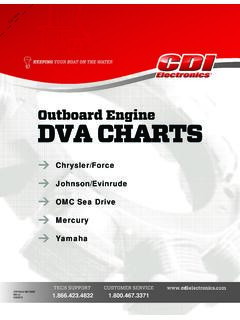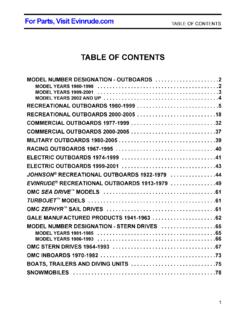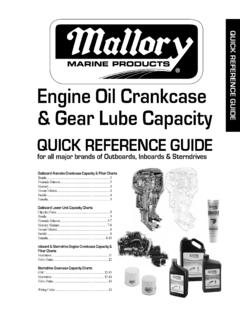Transcription of 2006 Evinrude E-TEC Outboards - iiNet
1 Iame 48 PWD Page 1 of 8 2006 Evinrude E-TEC Outboards Two years ago Evinrude announced the release of the first E-TEC engines, ranging from 40 to 90 HP. These were revolutionary 2-stroke engines with lower emissions, better economy and less maintenance than 4-strokes. Last year the Litre V6 E-TEC engines of 200 to 250 HP appeared to rave reviews of their performance, economy and quiet operation. Now for 2006 the 60 degree V4 and V6 engines between 115 and 200 HP will arrive. The 2006 E-TECs not only continue the E-TEC philosophy, but add some new features the industry s first electronically controlled tuned exhaust systems. Tuned exhaust systems on 2-stroke engines have been around since the early 1960 s on motorcycles and go-karts where they were also very visible.
2 The first tuned exhaust systems on production Outboards happened in 1966, but these were well hidden inside the engine casings. It consisted of a short megaphone suspended inside a rectangular box and made some use of the pressure wave energy available in the exhaust gasses to increase the charge in the cylinder. 3 Cylinder outboard engines also started to appear in the 1960 s for the very good reason that having 120 degrees between cylinder firings just happens to provide nearly ideal spacing for a tuned exhaust system. That is the pressure wave created in the exhaust system when an exhaust port opens just happens to be at the same time as another exhaust port is closing, raising the pressure in that cylinder by pushing back some of the over scavenged fuel and air.
3 Having higher pressure in the cylinder just after the exhaust port closes is like a little free supercharging, providing a power boost and better economy through less wastage of fuel out the exhaust. In the mid 1970 s V6 outboard engines arrived and immediately power jumped by over 50HP. Although it was not very obvious at the time, one of the main reasons was exhaust tuning. V6 engines easily lend themselves to having two 3-cylinder exhaust systems neatly hidden away in the V of the engine. 1966 Johnson 100 HP with early tuned exhaust system One of 2 tuned 3-cylinder systems in a V6 mid-section Iame 48 PWD Page 2 of 8 However not all engine sizes can be 3 or 6 cylinders. Engines around the 100 to 130 HP range are too big for 3 cylinders and too expensive with 6 cylinders, so 4 cylinders is much more common.
4 4 cylinder 2-stroke engines fire every 90 degrees which makes for a nice smooth, low vibration engine, but the exhaust pressure waves travel across the exhaust system a little too early to be useful as a plugging pulse for another cylinder. By arranging the firing order to alternate between port and starboard sides on a V4, and keeping the port and starboard exhaust systems separate, the pressure waves then need to travel to the base of the engine then up the other side. This lengthens the wave travel path and helps to get it to arrive at the right time, but it was still not quite as good as a 3 cylinder system. Then in the mid-1990 s the U tube exhaust system arrived. The join between port and starboard exhaust systems now extended well down into the mid-section of the engine, increasing the exhaust pressure wave travel distance and improving the tuning.
5 The 2006 Evinrude E-TEC 2 and 4 cylinder engines now add electronic control to vary the tuning at different engines speeds to provide a very broad flat torque curve. The new 60HP E-TEC is an 860cc twin cylinder engine. Two cylinders fire too far apart to allow the pressure wave from one cylinder to be used as a plugging pulse for the other cylinder, so the exhaust system utilizes a reflection of the pressure wave from the same cylinder. The tuned exhaust system in the engine s mid-section resembles an expansion chamber system, but folded up to fit into the available space. A completely new, single piece lost-foam casting is required in order to fit the new larger system into the engine while still retaining room for the cooling system water pump, engine mounts and the driveshaft.
6 Exhaust gasses enter the system at top right. The exhaust gas outlet is at bottom centre. Pressure waves travel around the U shaped loop and U tube system on a V4 Red outline shows the shape of new single piece 60 E-TEC system compared with the blue line of previous multi-piece systems Exhaust from engine Gas exit to propeller Water entry point Iame 48 PWD Page 3 of 8 are reflected from the far end (upper centre on picture). The timing of the reflected wave is crucial to tuning and is determined by the distance it needs to travel and its speed. The new single-piece system has a large volume for a stronger reflection and greater length for best tuning effect at a lower RPM. In addition, water is injected into the system by the Engine Management Module (EMM) switching on a solenoid valve when it senses high throttle opening.
7 Cool water on its way into the engine is injected by the solenoid valve, lowering the gas temperature inside the tuned section and slowing down the wave speed. Pressure waves in the exhaust gas travel at the speed of sound, about 1100 kph in the atmosphere at room temperature, but in the exhaust gas where temperatures get to 500C+ it can be 1500 kph, so cooling the gas temperature has a large effect on the timing of the pressure waves and therefore the engine speed where the exhaust tuning works best. The EMM monitors throttle opening and RPM, and when the throttle opening is above 80% water is injected between 2500 and 4500 rpm. The result? Between 3500 and 4500 RPM, at full throttle, power is increased by around 5 HP or more than 10%. Above 4500 rpm the system is dry to get the fastest pressure wave travel for best power at high RPM.
8 New V4 and V6 Small Block E-TECs 2006 also sees the long awaited release of the Litre V4 and litre V6 E-TEC models, with outputs between 115 and 200 HP. These new engines now fill the gaps in the E-TEC range so there s now a full range from 40 to 250 HP. To enhance quality and durability, E-TEC models use many common components across the model range. The 40 to 200 HP range utilizes 2, 3, V4 and V6 cylinder engine all with identical bore and stroke. These models use the same Piston rings Crankshaft bearings Con Rods Cylinder heads (starboard head on V engines same as 2 or 3 cyl inline engine) Electronic sensors for engine management Linkages and external hardware. In addition the mid-sections, gearcases and crankshafts are shared over several models.
9 The new V4 and V6 models from 115 to 200 HP all share a 60 degree V angle and 2030405060702500300035004000450050005500 6000 RPMBHPWith Water InjectionWithout Water Injection Power output curves for the 60 HP E-TEC , with and without water injection into the exhaust system. Iame 48 PWD Page 4 of 8 the same bore and stroke as previous Evinrude 60 degree V angle engines, but that s where the similarity ends. The E-TEC models have a newly designed lost foam cast cylinder block with larger air intakes and reed valves, more cooling system area and a larger, more free-flowing exhaust system. Lost foam castings allow very complex shapes to be cast in a single piece allowing freedom from the need for many fasteners to hold several pieces together and all the room they need along with gaskets to seal the joints.
10 The process is simple, make a cylinder block out of many small pieces of polystyrene foam glued together to get the desired shape. Coat the resulting assembly in a hard ceramic shell by dipping in a slurry solution then baking in an oven. Now support foam block and its ceramic shell in a sand box to hold its shape while you pour in the molten metal. The molten metal vapourises the foam and takes its exact shape. After it s cooled, you vibrate the new casting to break away any remaining ceramic shell (it also cracks a lot during the cooling), then it s ready for machining and surface coatings. The new 115 and 130 HP V4 E-TEC models also introduce an electronically controlled tuned exhaust system, but being a 4 cylinder engine it requires a different method than that describe above for the 60 HP.











